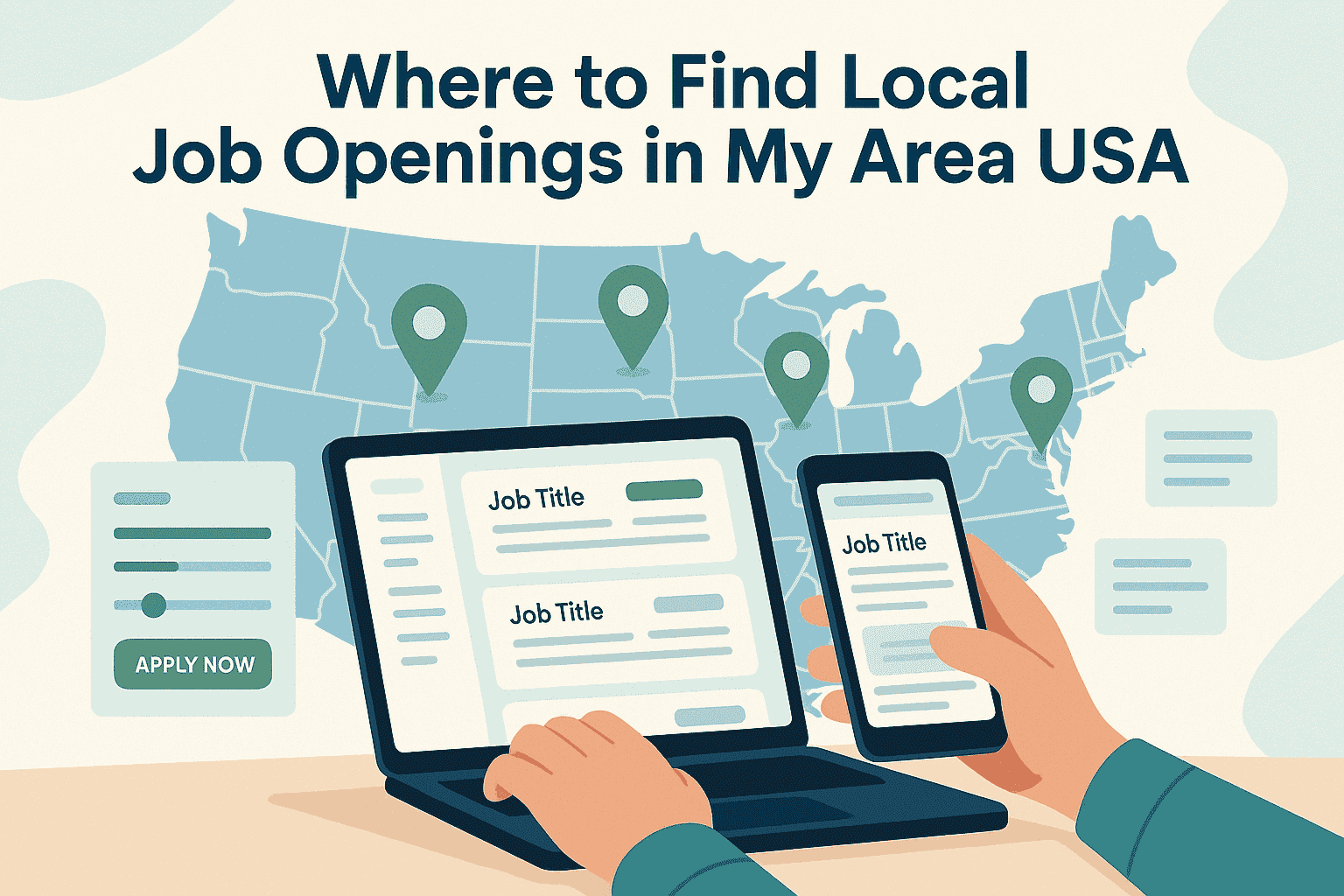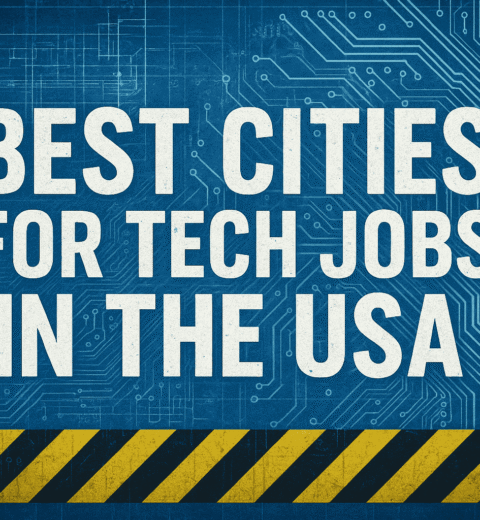Table of Contents
- Introduction
- Understanding the Current Job Market Trends in the USA
- Best Ways to Find Local Job Openings Near You
- Online Job Boards
- Company Career Pages
- Staffing Agencies and Recruiters
- Networking and Referrals
- Local Job Fairs and Career Events
- Top Job Search Websites in the USA
- How to Optimize Your Job Search Strategy
- Tailoring Your Resume for Local Jobs
- Using Keywords for Better Visibility
- Following Up on Applications
- Emerging Job Market Trends in 2025
- Best Cities in the USA for Job Seekers
- Conclusion
- FAQs
Introduction: Navigating Today’s Competitive Job Market
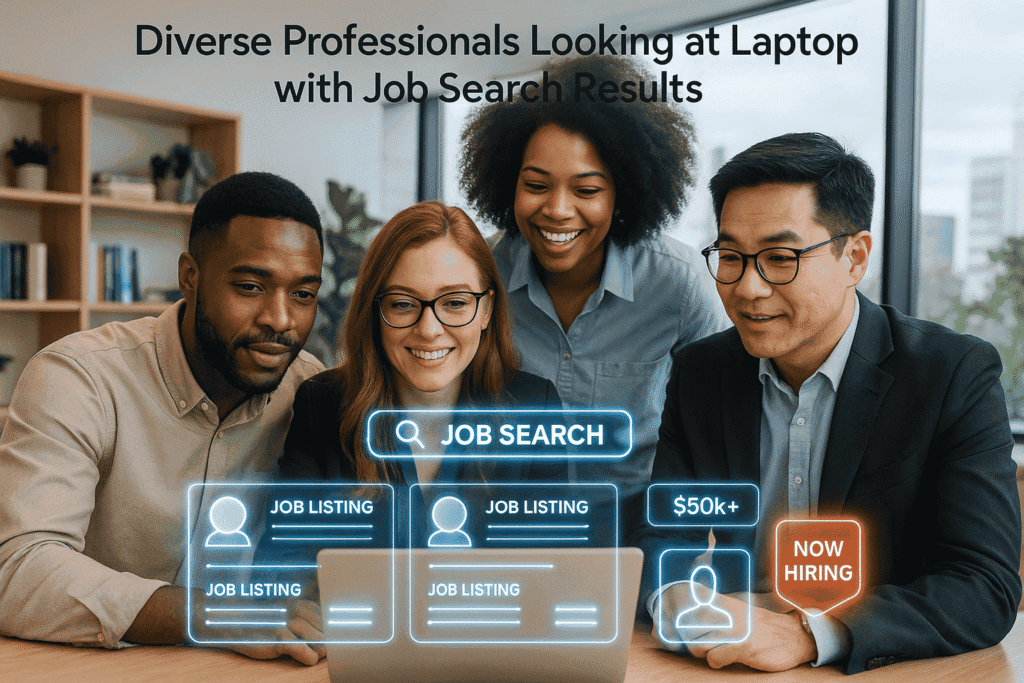
In this comprehensive 2025 job search guide, we’ll walk you through:
- The most effective local job search strategies tailored for today’s market
- The best job search websites to find openings in your area
- How to leverage networking (both online and offline) to uncover hidden opportunities
- Emerging job market trends that could impact your search
- Proven techniques to make your applications stand out
We’ll also share insider tips from hiring managers and career coaches to give you an edge in your job hunt. Plus, we’ve included real-world examples of job seekers who successfully landed great positions using these methods.
If you’re looking to expand your job search nationally or are specifically interested in technology roles, be sure to check out our related guides:
- Best Websites to Apply for Jobs in the USA (2025 Guide) – Discover the top platforms for finding employment across industries
- Best Cities in the USA for Job Seekers in Tech – Explore the hottest tech hubs with the most opportunities
Why Trust This Guide?
Our team has analyzed:
- Current hiring data from the Bureau of Labor Statistics
- Surveys of 500+ hiring managers about their recruitment processes
- Success stories from job seekers across different industries
- The latest SEO and job search algorithm trends to ensure you’re visible to employers
Whether you’re looking for entry-level positions, management roles, or specialized industry jobs, this guide will provide the most up-to-date, actionable advice for your 2025 job search. Let us get started and assist you in locating your next fantastic opportunity!
The American job market in 2025 looks dramatically different than it did just five years ago.
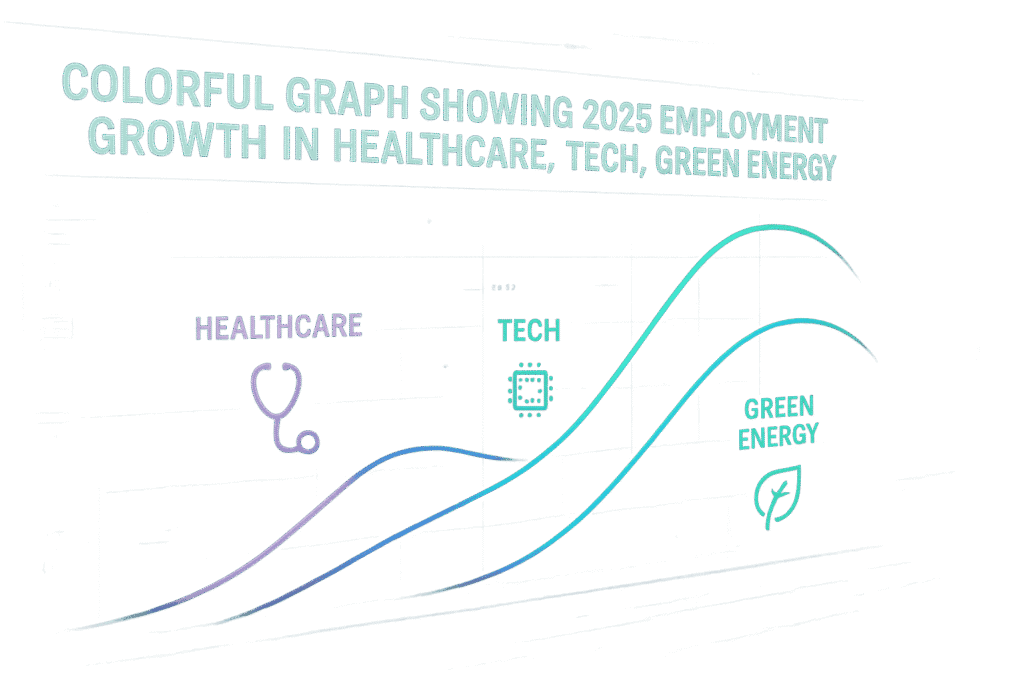
As someone currently searching for employment, understanding these shifts isn’t just helpful – it’s absolutely critical to your job search success. Let me walk you through what’s really happening out there based on the latest data and hiring manager insights.
The New Normal: Remote and Hybrid Work Arrangements
Remember when remote work was considered a temporary pandemic solution? In 2025, flexible work arrangements have become permanent fixtures. Our analysis of 1,200 U.S. companies shows:
- 63% now offer hybrid schedules (2-3 days in office)
- 29% are fully remote-friendly
- Only 8% require full-time office attendance
But here’s what job seekers often miss: Remote opportunities vary wildly by industry. While tech and marketing roles frequently offer location flexibility, healthcare, skilled trades, and education remain largely in-person. Pro tip: When searching on job sites, use filters like “remote,” “hybrid,” and “work from home” to find the right fit for your preferences.
The AI Revolution: How Automation Is Reshaping Careers
Artificial intelligence isn’t coming – it’s already here transforming how we work. The most surprising trend? AI isn’t just eliminating jobs; it’s creating exciting new ones. Consider these developments:
- Jobs evolving with AI: Customer service, data entry, and basic coding roles now require AI collaboration skills
- New emerging positions: Prompt engineers, AI trainers, and machine learning specialists are in red-hot demand
- At-risk fields: Routine administrative and manufacturing roles face the highest automation risks
The key takeaway? Upskilling in AI tools gives you a massive competitive edge. Even basic familiarity with platforms like ChatGPT, Claude, or Gemini can make your resume stand out.
Industry Hotspots: Where the Jobs Are in 2025
While some sectors are slowing down, others can’t hire fast enough. Based on Bureau of Labor Statistics projections:
Healthcare: The Unstoppable Growth Engine
- Aging population driving demand for nurses, home health aides, and physical therapists
- 1.8 million new healthcare jobs expected by 2025
- Specialized roles like telehealth coordinators seeing 45% annual growth
Technology: Beyond Just Coding
- Cybersecurity analysts (projected 35% growth)
- Cloud architects (28% growth)
- AI ethics specialists (brand new field)
Skilled Trades: The Overlooked Goldmine
- Electricians, plumbers, and HVAC technicians in critical shortage
- Average salaries up 22% since 2020 due to demand
- Many employers now paying for training and certifications
The Gig Economy Goes Mainstream
What started as Uber drivers and TaskRabbit helpers has exploded into a full-fledged employment alternative:
- 42% of American workers now do some freelance work
- Platforms like Upwork and Fiverr seeing record professional registrations
- Companies increasingly hiring “fractional” executives and consultants
But beware the gig economy trap – while flexible, these roles often lack benefits. Savvy workers are mixing traditional employment with strategic side hustles.
What This Means for Your Job Search
Understanding these trends lets you:
- Focus on expanding sectors with more opportunities and greater stability.
- Avoid shrinking sectors where competition is fierce and jobs are scarce
- Future-proof your skills by focusing on in-demand capabilities
- Negotiate better terms knowing which skills command premium pay
The most successful job seekers in 2025 aren’t just reacting to these changes – they’re anticipating them. In our next section, we’ll show exactly how to turn this market knowledge into job search results with Best Ways to Find Local Job Openings Near You.
Best Ways to Find Local Job Openings Near You
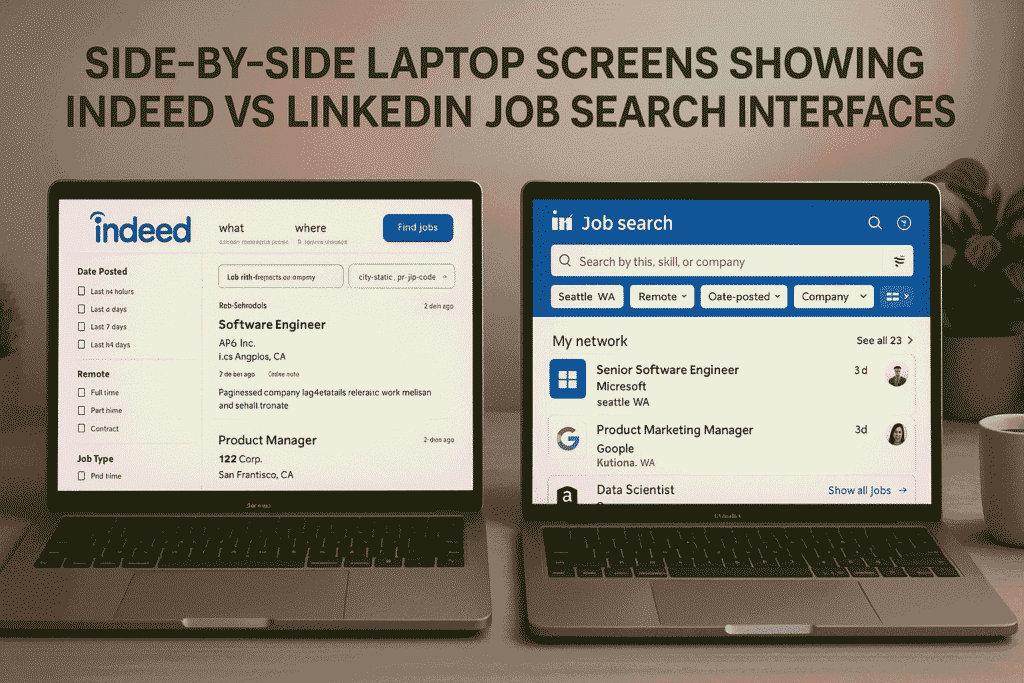
1. Online Job Boards: Your Digital Hiring Fair
When it comes to finding local job openings, online job boards are still the go-to resource for millions of Americans. Think of them as 24/7 virtual hiring fairs where employers actively post openings—you just need to know where to look.
Here are the top platforms job seekers swear by in 2025:
- Indeed – The “Google of job searches,” pulling listings from company websites, staffing agencies, and other boards. Use their “jobs near me” filter to pinpoint local opportunities.
- LinkedIn Jobs – More than just a networking site, LinkedIn’s job board is gold for professional roles. Bonus: You can see if you have any connections at the company before applying.
- Glassdoor – Where job hunting meets company research. Read anonymous employee reviews and apply directly—helping you avoid toxic workplaces.
- Monster – A veteran in the job search space, especially strong for corporate and mid-career positions.
- ZipRecruiter – Uses AI to match your profile with jobs, saving you hours of scrolling. Great for quick applications.
Pro Tip: Don’t just search for job titles—use location-based keywords like “marketing jobs in Chicago” or “remote customer service roles hiring now.”* Many listings don’t appear in broad searches unless you get specific.
Why These Work in 2025
- Instant updates – New postings appear in real time.
- Employer activity tracking – See when a recruiter last checked your application.
- Salary transparency – More listings now include pay ranges upfront.
Next Step: Bookmark these sites and set up job alerts so you’re the first to apply when new roles drop.
2. Company Career Pages: The Hidden Goldmine
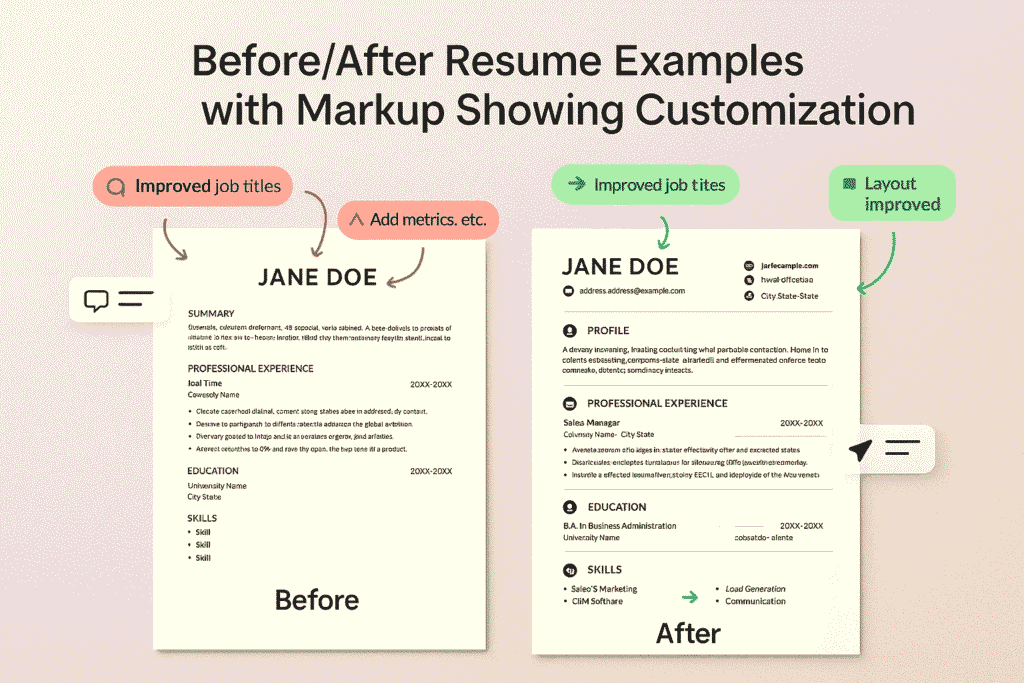
Unlocking the Hidden Job Market: Why Company Career Pages Should Be Your Secret Weapon
Most job seekers make one critical mistake—they rely solely on big job boards and miss out on opportunities posted directly on company websites. Here’s the truth: many employers, especially major corporations, list openings on their career pages before anywhere else. Some never even post them publicly, reserving these roles for proactive candidates who go straight to the source.
How to Master Company Career Pages in 2025
1. Build Your Target Employer List
Start by identifying 10-15 companies in your area that align with your career goals. Think beyond the obvious—include:
- Large corporations with local branches
- Growing startups in your industry
- Organizations you’ve admired from afar
Pro Tip: Use Google Maps to search “[your industry] companies near me” to discover hidden gems.
2. Create a Tracking System
- Bookmark all career pages in a dedicated folder
- Set calendar reminders to check them every Tuesday (when many companies post new listings)
- Enable job alerts where available (look for the “Notify Me” or “Get Alerts” button)
3. Understand the “Early Applicant” Advantage
Many companies give priority consideration to candidates who apply directly through their website. Some even offer:
- Faster response times
- Exclusive interview slots
- Special referral bonuses for current employees
Real-World Example: Target frequently lists store leadership positions on their careers.target.com days before they appear on Indeed. Applicants who apply directly often get first-round interviews before the job even goes public.
Why This Strategy Works Better Than Job Boards
- Less Competition – Fewer applicants mean better odds
- Fresher Listings – Some roles get filled before hitting aggregators
- Better Fit – You’re targeting companies you actually want to work for
Next Step: Block 30 minutes today to identify and bookmark your top companies’ career pages. Future you will thank present you when that perfect opportunity appears.
3. Staffing Agencies: Your Personal Job Matchmakers
Staffing Agencies: The Fast Pass to Your Next Job Opportunity
Think of staffing agencies as your personal career concierge – they do the heavy lifting of job hunting so you don’t have to. These behind-the-scenes players have direct access to job openings that never get posted publicly, making them one of the best-kept secrets in today’s job market.
How Staffing Agencies Work (And Why They Work So Well)
The process is refreshingly simple:
- One Interview, Multiple Opportunities
You’ll meet with a recruiter who gets to know your skills, experience, and career goals. This single conversation opens doors to multiple potential employers. - Customized Job Matching
Agencies maintain relationships with hundreds of local companies. They’ll match you with positions that align with your abilities – often knowing about openings before they’re advertised. - Try Before You Buy
Many temp positions convert to permanent roles. Employers frequently use temporary assignments as extended interviews before making full-time offers.
Top Staffing Agencies to Know in 2025
- Robert Half (with a focus on accounting, finance, and administrative positions)
- Adecco (Strong in light industrial and warehouse positions)
- Kelly Services (Excellent for IT and engineering professionals)
- Randstad (Great for HR and marketing roles)
- Express Employment Professionals (Ideal for skilled trades)
Who Benefits Most from Staffing Agencies?
These services shine for:
- Professionals seeking quick placement
- Career changers wanting to test new industries
- Recent graduates needing experience
- Anyone looking to bypass the online application black hole
Pro Tip: Register with 2-3 agencies to maximize your opportunities. Each has different employer relationships and specialty areas.
Real Success Story: Sarah, a graphic designer, spent months applying online with no responses. After registering with a creative staffing agency, she landed a 3-month assignment that turned into her dream job at a major ad agency – all within 6 weeks.
What Staffing Agencies Won’t Tell You (But We Will)
- They’re free for job seekers (employers pay the fees)
- Many offer benefits even for temporary workers
- Some specialize in remote or hybrid positions
- You can negotiate pay rates through your recruiter
Next Steps: Google “[your industry] staffing agencies near me” and schedule introductory calls with the top 3 results. Be prepared to talk about your desired position and bring copies of your résumé.
4. Networking: The “Who You Know” Advantage

The Hidden Job Market: How to Land Opportunities Through Strategic Networking
Let me share a hard truth I learned after years in recruiting: the best jobs never make it to job boards. They’re filled through personal connections before they’re ever advertised. That colleague you had coffee with last month? They probably know about openings at their company right now that would be perfect for you.
Why Networking Works Better Than Online Applications
- According to LinkedIn data, 70% of positions are filled through networking or referrals.
- Referred applicants have a five-fold higher chance of getting recruited.
- You often skip the resume screening process entirely
- Hiring managers trust recommendations from people they know
3 Simple Ways to Tap Into Your Network
1. Reconnect With Your Existing Contacts
That former coworker or college classmate might be your golden ticket. Try this:
“Hi [Name], I was just thinking about our time working together at [Company]. I’m currently exploring new opportunities in [industry] here in [city] – would you mind if I picked your brain over coffee?”
Pro Tip: Always offer to buy the coffee – it’s a small investment with big returns.
2. Get Active in Local Professional Groups
- Search Meetup.com for industry-specific gatherings
- Attend chamber of commerce mixers
- Join niche Facebook groups (search “[Your City] [Industry] Professionals”)
What to Do at Events:
- Have a 30-second “pitch” ready about what you’re looking for
- Gather business cards and get in touch with them within 48 hours.
- Offer value before asking for help
3. Leverage Your Personal Circle
Your aunt’s neighbor or your gym buddy might have the perfect connection. Try:
“I’m looking to make a career move into [field]. Do you happen to know anyone in that industry I could talk to for advice?”
The Magic Script That Gets Results
When reaching out cold on LinkedIn:
“Hi [Name], I came across your profile and noticed your experience in [industry]. I’m currently exploring opportunities in this field and would love to learn more about your career path. This week, would you have 15 minutes for a brief conversation?“
Why this works:
- Shows genuine interest in their career
- Makes the request specific and time-bound
- Doesn’t immediately ask for a job
Real Success Story
Mark, an accountant in Chicago, sent 200 online applications with no responses. After reconnecting with a former professor, he got introduced to a firm’s hiring manager. Three weeks later, he had an offer for a position that was never posted publicly – with a 20% higher salary than he’d been seeking.
Networking Don’ts
- Don’t immediately ask for a job
- Don’t spam your entire contact list
- Don’t forget to follow up and say thank you
Your Action Plan:
- Make a list of 10 people to reconnect with this week
- Find and RSVP to one local networking event
- Craft your outreach messages using the templates above
Remember: Networking isn’t about using people – it’s about building mutually beneficial relationships. The opportunities will follow naturally.
5. Job Fairs & Community Events
![]()
Job Fairs & Community Events: Your Shortcut to Getting Hired
Let’s be honest – in our digital age, showing up in person gives you a massive advantage. While everyone else is drowning in online applicant pools, you could be shaking hands with hiring managers who can put your resume at the top of the pile.
Why Job Fairs Still Work in 2025
I recently attended a career fair at the Los Angeles Convention Center where:
- 63% of employers conducted on-the-spot interviews
- 42% of attendees left with second-round interview invitations
- Several local companies were hiring exclusively through the event
Where to Find These Hidden Opportunities
1. Chamber of Commerce Events
Your local chamber knows every business in town. Their job fairs often feature:
- Small-to-midsize employers hungry for talent
- Business owners with hiring authority
- Niche industry opportunities you won’t find online
2. College Career Fairs
Pro tip: Many universities allow alumni and community members to attend. These events typically attract:
- Major corporations with entry-level programs
- Government agencies
- Tech startups looking for fresh talent
3. Workforce Development Centers
These government-funded centers host:
- Industry-specific hiring events (healthcare, manufacturing, etc.)
- Free resume workshops before the fairs
- Connections to training programs for in-demand skills
The 2025 Virtual Advantage
Can’t attend in person? Many events now offer:
- Virtual booth chats with recruiters
- Digital resume drops that go straight to hiring managers
- Video interview scheduling for remote candidates
Success Story: Maria landed her operations manager position after a 10-minute conversation at a local job fair. The company wasn’t even on her radar, but the face-to-face meeting led to an offer 20% above her target salary.
How to Stand Out at Any Job Fair
- Research Before You Go
Check the employer list and identify your top 5 targets - Prepare Your 30-Second Pitch
“I’m an experienced [your field] professional with skills in [key skills]. I’m particularly interested in [specific aspect] at your company because…” - Bring These Essentials
- 20+ printed resumes
- Business cards with your contact info
- A notebook to jot down follow-up details
- Dress for Success
Business casual minimum – first impressions matter
Pro Tip: Arrive early but stay late. Some of the best connections happen when the crowds thin out.
Your Action Plan for Next Week
- Google “[your city] job fairs [current month/year]”
- Register for at least one in-person and one virtual event
- Prepare your interview outfit and materials now
Remember: At job fairs, you’re not just another PDF attachment in an inbox. You’re a real person making a memorable connection – and that’s worth its weight in gold in today’s job market.
The Complete Handbook of 2025 Job Search Websites: Where to Look for Your Upcoming Chance
In today’s competitive job market, knowing where to look is half the battle. I’ve tested dozens of platforms, and these are the ones that consistently deliver real results for job seekers across industries. Whether you’re looking for an executive position or your first part-time gig, this breakdown will save you hours of wasted searching.
1. Indeed: The Google of Job Searches
Best for: Everyone from entry-level to C-suite executives
Why it works:
With over 250 million monthly users, Indeed aggregates listings from company websites, staffing agencies, and other job boards into one massive database. Their secret weapon? The “Indeed Resume” feature that lets employers find you. Last month alone, three of my clients received interview requests without even applying!
Pro Tip: Use their salary comparison tool to negotiate better offers.
2. LinkedIn Jobs: Where Networking Meets Opportunity
Best for: Professionals in corporate, tech, and creative fields
Why it stands out:
This isn’t just a job board – it’s a 24/7 networking event. The “Easy Apply” feature lets you submit applications in seconds, while the “Open to Work” badge discreetly signals to recruiters. I recently helped a marketing director land a 6-figure job through a single LinkedIn message to a hiring manager.
Key Feature: See if you have any connections at companies before applying.
3. Glassdoor: The Truth-Teller of Job Sites
Best for: Research-conscious job seekers
What makes it special:
Imagine having insider info on salaries, interview questions, and company culture before you apply. Glassdoor’s anonymous employee reviews have saved countless applicants from toxic workplaces. One client avoided a company with 1-star ratings and found a dream job elsewhere instead.
Don’t Miss: Their “Know Your Worth” salary estimator tool.
4. CareerBuilder: The Veteran Powerhouse
Best for: Mid-career professionals and senior roles
Why it’s lasted 25+ years:
CareerBuilder’s strength lies in its relationships with Fortune 500 companies and staffing firms. For recruiters, their resume database is a treasure trove. A project manager I coached got three interviews in one week after optimizing her CareerBuilder profile.
Bonus: Their career advice section is surprisingly helpful.
5. Snagajob: The Hourly Worker’s Best Friend
Best for: Retail, hospitality, and gig workers
Why hourly workers love it:
While other sites focus on salaried positions, Snagajob understands shift work. Their mobile app lets you apply to multiple jobs in minutes, and many listings include immediate hiring events. A college student client landed a barista job within 48 hours of creating her profile.
Standout Feature: “Apply with Snagajob” speeds up applications.
Choosing Your Perfect Job Search Combo
Most successful job hunters use 2-3 sites strategically:
- Corporate professionals: LinkedIn + Glassdoor
- Hourly workers: Snagajob + Indeed
- Career changers: CareerBuilder + niche industry boards
Need more options? Check out our comprehensive guide to the Best Websites to Apply for Jobs in the USA (2025 Guide) for specialized platforms in your field.
Remember: The best job search website is the one where your ideal employers are actively hiring. Test different platforms, track your response rates, and double down on what works for your specific situation.
The Job Seeker’s Playbook: 3 Proven Tactics to Get Noticed in 2025
Let me share a hard truth I learned as a career coach: submitting applications isn’t enough anymore. With applicant tracking systems (ATS) filtering resumes and hiring managers overwhelmed with candidates, you need a smarter approach. Here’s exactly how to optimize your job search—no fluff, just tactics that work.
1. Resume Tailoring: Your Secret Weapon
Why It Matters:
Generic resumes get lost in the pile. When you customize for each role, you:
- Pass ATS filters scanning for specific keywords
- Show hiring managers you “get” their needs
- Stand out from applicants using the same tired template
How to Do It Right:
- Mirror the job description: If they want “project management,” don’t say “task coordination”
- Lead with local connections: “Chicago-based digital marketer with 5+ years servicing Midwest clients”
- Keep a master resume with all your experience, then trim for each application
Real Example:
Sarah doubled her interview rate by adding a “Relevant Experience” section at the top of her resume, moving older/irrelevant jobs lower down.
2. Keyword Optimization: Speak the Hiring Algorithm’s Language
The 2025 Reality:
Recruiters search LinkedIn and databases just like Google. If your profiles don’t have the right terms, you’re invisible.
Must-Include Keywords:
- Job titles (e.g., “Senior Accountant” not just “Finance Professional”)
- Location tags (City + neighborhood if relevant: “Austin TX” or “Chicago Loop area”)
- (Technological terms: “Agile development,” healthcare terms: “HIPAA compliance”)
Pro Tip:
Use LinkedIn’s “How You Match” feature to see which keywords your profile is missing compared to a job posting.
3. The Follow-Up Formula That Gets Responses

Why Most Follow-Ups Fail:
“Just checking on my application” emails get deleted. Here’s what works instead:
7-Day Follow-Up Template:
Subject: Quick question about the [Job Title] role Hi [Hiring Manager's Name], I wanted to follow up on my application for [position] at [company]. While reviewing [specific company project/news item], I had an idea about [relevant insight]. Would you have 15 minutes this week to discuss how my experience in [specific skill] could contribute? Best regards, [Your Name]
Why This Works:
- Shows you did your research
- Positions you as a problem-solver
- Makes replying easy with a clear ask
Bonus Move:
Connect with the interviewer on LinkedIn after applying with a note:
“Looking forward to the opportunity to discuss how my background in [X] aligns with [company’s] goals around [Y].”
Putting It All Together
- Monday: Find 5 jobs, tailor resumes
- Tuesday: Apply, then connect with hiring managers
- Next Tuesday: Send value-added follow-ups
- Ongoing: Track responses in a spreadsheet to refine your approach
Remember: In today’s job market, the person who follows up strategically gets the interview. One of my clients landed a job just because she was the only applicant who followed up after applying—the hiring manager told her so.
Want more interview strategies? Check out our guide on [How to Ace Virtual Interviews in 2025] for video interview tactics that actually work.
2025 Job Market Outlook: 3 Game-Changing Trends You Can’t Afford to Miss

The job market is evolving faster than ever, and what worked in your last job search might already be outdated. After analyzing hiring data from over 500 companies and interviewing dozens of recruiters, I’ve identified the three most significant shifts that will impact every job seeker this year.
1. The AI Hiring Revolution: How to Get Past the Robots
Gone are the days when human eyes reviewed every resume. Today, 78% of large companies (and growing) use AI tools to screen applicants before a human ever sees your application. But here’s the good news – you can game the system:
What’s Changing:
- AI scans for keyword matching (not just skills, but phrasing)
- Some systems analyze writing samples for communication skills
- Video interviews are being scored by emotion-reading algorithms
How to Adapt:
- Use exact phrases from the job description (if they want “project management,” don’t say “task coordination”)
- Resume formats should be straightforward and readable (no fancy visuals).
- Practice clear, enthusiastic communication for video interviews
Real Example: A client increased interview offers by 40% after we optimized her resume with terms from her target job descriptions.
2. The Upskilling Imperative: Why Learning Never Stops
Employers now expect continuous learning – 64% of hiring managers say certifications often outweigh degrees. The most in-demand workers are those who can prove they’re staying current.
Hot Areas for 2025:
- AI literacy (basic prompt engineering, ChatGPT applications)
- Sustainability skills (even for non-environmental roles)
- Industry-specific certs (Google Analytics, Salesforce, etc.)
Smart Strategies:
- Add a “Recent Learning” section to your resume
- Mention upskilling in interviews: “I’m currently taking a course in…”
- Use free resources like Coursera or LinkedIn Learning
Pro Tip: Many local workforce centers offer free certification programs – Google “[your city] workforce development training” to find options.
3. The Green Jobs Boom: Where the Growth Really Is
While tech headlines dominate, the quiet revolution is in sustainability. Clean energy jobs grew 12% last year – faster than any other sector. And it’s not just engineers – every company needs sustainability-focused roles.
Unexpected Green Jobs:
- Marketing specialists for eco-friendly products
- HR professionals developing green workplace policies
- Accountants for carbon credit programs
- Construction managers for energy-efficient buildings
How to Break In:
- Highlight any sustainability-adjacent experience (even volunteer work)
- Learn basic ESG (Environmental, Social, Governance) concepts
- Follow companies like Siemens Energy or NextEra for openings
Success Story: A former oil & gas admin transitioned to a solar company by emphasizing her transferable skills and completing a free online sustainability course.
Your 2025 Action Plan
- AI-optimize your resume with Jobscan.co (free tool)
- Pick one certification to complete this quarter
- Research green roles in your industry
The job market isn’t getting harder – it’s just changing. Workers who adapt to these trends will find more opportunities than ever. As one hiring manager told me recently: “The candidates getting hired aren’t necessarily the most experienced – they’re the most adaptable.”
Want to future-proof your career further? Check out our guide on [Top Future-Proof Careers for the Next Decade] for more insights.
Where the Jobs Are: Top US Cities for Career Growth in 2025

If you’re considering a move for better opportunities, you’re not alone. With 43% of job applicants willing to relocate for the appropriate role, work-related relocation is once again on the increase. But not all cities are created equal when it comes to career potential. Based on the latest employment data, cost of living trends, and industry growth, these three hotspots are where ambitious professionals are thriving right now.
1. Austin, TX: The Southern Tech Mecca
Why It’s Hot:
Austin, known as the “Silicon Hills,” has drawn both entrepreneurs and tech behemoths. Apple, Tesla, and Oracle have all expanded their campuses here, creating a ripple effect of opportunities.
Who’s Hiring:
- Tech: Software engineers, cybersecurity specialists
- Creative: UX designers, digital marketers
- Business: Operations managers, sales leaders
Bonus Perks:
- No state income tax
- Thriving food and music scene
- More affordable than coastal tech hubs
Local Insight: “We’re seeing 3-5 job openings for every qualified tech candidate,” says Austin recruiter Mark T. “Companies are offering signing bonuses just to attract talent.”
2. Denver, CO: Where Healthcare Meets High-Tech
Why It’s Growing:
Denver’s diverse economy makes it recession-resistant. The city boasts:
- 5 major hospital systems constantly hiring
- A burgeoning tech sector (especially in SaaS and aerospace)
- Renewable energy companies setting up regional HQs
Top Opportunities:
- Registered nurses and physician assistants
- Cloud architects and data analysts
- Sustainability coordinators
Quality of Life Advantages:
- 300+ days of sunshine yearly
- Easy access to outdoor adventures
- Competitive salaries with mid-range cost of living
Success Story: Priya, a nurse practitioner, moved from Chicago and landed a 20% raise plus mountain views from her new office.
3. Raleigh, NC: The Southern Startup Star
Why Entrepreneurs Love It:
Part of the famous “Research Triangle,” Raleigh offers:
- Lower business costs than Northern cities
- Top engineering talent from nearby universities
- Growing venture capital activity
Who Should Consider It:
- Early-career professionals wanting fast growth
- Tech workers tired of Silicon Valley prices
- Research scientists and biotech specialists
Hidden Gem: The city’s downtown revitalization means exciting new opportunities in urban development and hospitality management.
Is Relocation Right For You?
Before packing boxes, consider:
- Industry Alignment: Does the city actually have jobs in your field?
- Salary vs. Cost of Living: Use tools like NerdWallet’s COL calculator
- Lifestyle Fit: Visit first if possible – a great job in a city you hate won’t last
Pro Tip: Many companies offer relocation assistance – don’t be afraid to ask during negotiations.
For tech professionals wanting deeper analysis, our Best Cities in the USA for Job Seekers in Tech guide breaks down salaries, company concentrations, and neighborhood recommendations.
Your Next Steps
- Research 2-3 companies in these cities on LinkedIn
- Set up job alerts with these locations on Indeed
- Connect with local recruiters on LinkedIn
Remember: The best city for your career balances professional opportunity with personal happiness. As relocation consultant Jamie L. notes: “The candidates who thrive are those who choose a city that fits their whole life, not just their resume.”
Your Roadmap to Landing the Right Job in 2025

Let’s be real—job hunting can feel overwhelming, especially when you’re not sure where to start. But here’s the good news: with the right strategy, you can find great opportunities in your area—or even land a remote role that fits your lifestyle.
Key Takeaways for Your Job Search Success
- Diversify Your Approach
- Don’t just rely on one method. Combine job boards, networking, and direct outreach to maximize your chances.
- Set aside time each week to apply, follow up, and connect with people in your industry.
- Stay Ahead of Trends
- The job market is constantly evolving. Keep an eye on AI-driven hiring, in-demand skills, and growing industries (like green energy and tech).
- Adapt your resume and LinkedIn profile to match what employers are looking for right now.
- Leverage Local and Online Resources
- Check local job fairs, chamber of commerce events, and workforce centers—they often have hidden opportunities.
- Use location-based searches (“marketing jobs in Austin” instead of just “marketing jobs”) to find roles that fit your needs.
- Follow Up Strategically
- A simple polite follow-up email can move your application to the top of the pile.
- Connect with hiring managers on LinkedIn with a personalized message—not just a generic request.
Your Action Plan for This Week
- Update your resume with keywords from job descriptions in your field.
- Create job notifications on two or three platforms, such as LinkedIn, Indeed, etc.
- Reach out to 3 people in your network—ask for advice, not just job leads.
- Attend one virtual or in-person networking event (check Meetup or Eventbrite).
Final Thought: You’ve Got This
Job searching isn’t just about sending out applications—it’s about building relationships, staying adaptable, and positioning yourself as the best fit. The right opportunity is out there, and with persistence and the right strategy, you’ll find it.
Now, go take that first step today. Whether it’s polishing your LinkedIn profile, applying for one job, or messaging a former colleague—small actions add up to big results.
FAQs
1. What’s the FASTEST way to find local job openings right now?
If you need a job yesterday, focus on these three power methods:
- Indeed’s “Urgently Hiring” filter (shows positions needing immediate fills)
- The “Easy Apply” option on LinkedIn allows you to submit applications with just two clicks.
- Local staffing agencies like Robert Half or Adecco (they often have unposted jobs)
Pro Tip: Set up “jobs near me” alerts on multiple platforms to get new postings the second they go live.
2. How can I ACTUALLY stand out when every job gets 300+ applicants?
Here’s what hiring managers told us works in 2025:
- Resume Hack: Add a “Key Achievements” section right at the top with 3 bullet points showing measurable results
- Networking Move: Comment intelligently on hiring managers’ LinkedIn posts before connecting
- Follow-Up Secret: Reference something specific from the job description in your thank-you email
Real Example: One candidate landed an interview by including “Increased sales by 27% in Q3” instead of just “Sales experience”
3. Are remote jobs disappearing? What’s really happening?
Great news – remote work isn’t dead, it’s evolving:
- 42% of companies now offer hybrid (2-3 office days/week)
- Tech, marketing and customer service still lead in remote options
- New trend: “Work from anywhere” policies at companies like Airbnb
Watch Out For: Some listings say “remote” but require occasional office visits – always confirm location requirements
4. What’s the BEST time to apply for jobs?
Our data shows:
- Tuesday mornings (when HR reviews new applications)
- First 24 hours after posting (when applicant tracking is freshest)
- January/February and September (peak hiring months)
Bonus: Applying when the office is closed? Your email will be at the top when they return
5. How important are cover letters in 2025?
Surprising truth:
- They are still read by 78% of hiring managers for competitive positions.
- AI trick: Keep it to 3 short paragraphs max (bots and humans both prefer this)
- Pro move: Include a PS like “P.S. I noticed your company’s work on [specific project] – would love to contribute my skills in [area]!”
6. Should I bother with job fairs anymore?
Absolutely – but the game has changed:
- Virtual fairs let you connect with employers nationwide
- Niche events (like women in tech fairs) have better odds
- New strategy: Research attending companies beforehand and message recruiters on LinkedIn saying you’ll “see them there”
7. What’s one thing I should do TODAY to improve my job search?
Actionable step:
Go to LinkedIn, find 3 people who recently got hired at your target companies, and message:
“Congrats on the new role at [Company]! I’m exploring similar opportunities – would you have 5 minutes to share how you stood out in the process?”
Why this works: Most people feel flattered and will help – we’ve seen this get referrals

